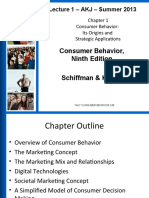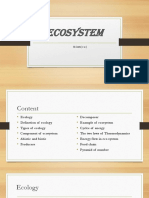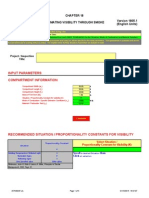Secondary Lesson Plan Template: Let Students Process and Get Their Misconceptions Out While Pulling Up The Video
Secondary Lesson Plan Template: Let Students Process and Get Their Misconceptions Out While Pulling Up The Video
Uploaded by
Kayla BrauerCopyright:
Available Formats
Secondary Lesson Plan Template: Let Students Process and Get Their Misconceptions Out While Pulling Up The Video
Secondary Lesson Plan Template: Let Students Process and Get Their Misconceptions Out While Pulling Up The Video
Uploaded by
Kayla BrauerOriginal Description:
Original Title
Copyright
Available Formats
Share this document
Did you find this document useful?
Is this content inappropriate?
Copyright:
Available Formats
Secondary Lesson Plan Template: Let Students Process and Get Their Misconceptions Out While Pulling Up The Video
Secondary Lesson Plan Template: Let Students Process and Get Their Misconceptions Out While Pulling Up The Video
Uploaded by
Kayla BrauerCopyright:
Available Formats
Secondary Lesson Plan Template Date: Monday, February 10th & Tuesday, February 11th Title: The Carbon
Cycle
Subject: Environmental Science Instruction time: 90 minutes Students level by grade: 11th & 12th grade Standard(s) to be addressed: 4E- I can describe which human actions affect the carbon cycle. Specific resources needed for this lesson: 18-24 ping pong balls to represent carbon atoms & role playing cards Lesson Sequence: Acorn to Tree discussion 1. How does a tree grow? a. Uses nutrients from the ground, sucks all of the nutrients up and into the tree. 2. Where does a trees mass come from? a. Nutrients in the ground. 3. What if I told you that a tree grows from this little tiny acorn and that the majority of its mass does not come from nutrients from the ground? Now, how does a tree grow? 4. What else do trees need besides water and sunlight to increase their mass? Let students process and get their misconceptions out while pulling up the video Veritasium video http://www.youtube.com/watch?v=2KZb2_vcNTg (This video addresses common misconceptions about where the mass of a tree actually comes from) What contains carbon? 1. Ask students, what contains carbon? a. Pencils, cup of water, wood, seashells, plastic, fabric, cotton, leather, paper. 2. So what is carbon? a. It is an element that is contained in living and non living things. 3. How does carbon help the planet? a. Carbon is an important element in living things. b. Plants need carbon dioxide to photosynthesize and grow. c. Carbon dioxide in the atmosphere keeps the planet warm and livable. d. Some of the things we use everyday contain carbon. 4. How does carbon hurt the planet? a. Too much carbon dioxide in the atmosphere changes the climate. b. Too much carbon dioxide dissolving in the ocean makes it more acidic. Many marine organisms make their skeletons out of calcium carbonate. They may decline and their ecosystems may be affected. 5. Why isnt it possible to decrease the total amount of carbon on earth?
a. Because there is a finite amount of carbon on earth. However, we can change the amount so that there is more or less in certain places. For plants and ocean animals, it is important for there to be certain levels of carbon in the atmosphere and ocean. Carbon cycle role play 1. Tell students that the carbon contained in any one thing doesnt stay there forever. The carbon contained in any one thing doesnt stay there forever. The carbon atoms move from one thing to another in what is called the carbon cycle. Parts of the carbon cycle happen very quickly, like when plants take in carbon dioxide from the atmosphere for photosynthesis. But, other parts of the carbon cycle happen very slowly. Tell students that in this activity, they will learn how carbon moves from one place to another, by performing a carbon cycle role-play. 2. Divide students evenly into 7 groups. Each group will be a team of actors that will play a certain part of the carbon cycle. Each group will receive one role playing card that can be referred to only if needed. 3. Distribute 2-4 ping pong balls to each group to represent carbon 4. Each group will work together to figure out where else they could send their carbon to as well as who else might be sending carbon to them. 5. Students will work as a group to decide where to send their carbon. As each individual group sends their carbon, the entire class will watch the transfer and decide if it is a correct transfer of carbon. 6. In the first round, each group can only give away one carbon atom at a time. Once they get the hang of it, have a second round where students can split their carbon between different groups. 7. Students must say their script lines to explain the carbon movement that they have chosen. 8. Realistically, multiple groups would move at once. In the real world, carbon moves between all of these areas at the same time. Conclusions How do humans impact the carbon cycle? o Humans extract and burn fossil fuels for energy. Carbon moves from the sediments and rock where fossil fuels are buried into the atmosphere. o Humans cut and burn trees to use land for farming, ranching, or building. Carbon moves from the land plants into the atmosphere.
You might also like
- Midterm Exam (Inorganic Chem and Organic Chemistry 2021Document14 pagesMidterm Exam (Inorganic Chem and Organic Chemistry 2021shaneeeeNo ratings yet
- Marketing CommunicationDocument8 pagesMarketing CommunicationAruna EkanayakaNo ratings yet
- BSBA New Books 2018Document11 pagesBSBA New Books 2018xxxx0% (1)
- Summary Consumer Behavior A European Perspective Solomon Lecture SDocument33 pagesSummary Consumer Behavior A European Perspective Solomon Lecture SMirna TadresNo ratings yet
- Calculation of Pressure Traverse Using Beggs and BrillDocument29 pagesCalculation of Pressure Traverse Using Beggs and BrillOba Fred Ajubolaka88% (8)
- Influence of Culture and Cross Culture On ConsumerDocument39 pagesInfluence of Culture and Cross Culture On ConsumerdurraizaliNo ratings yet
- STS Lecture 3 - MIDDLE AGES, MODERN TIMES, PHILIPPINE INVENTIONSDocument32 pagesSTS Lecture 3 - MIDDLE AGES, MODERN TIMES, PHILIPPINE INVENTIONSJohn Eldrin DuyagNo ratings yet
- pp08Document15 pagespp08kansanNo ratings yet
- Nitrogen Cycle: Ecological Planning - Assignment - 1Document13 pagesNitrogen Cycle: Ecological Planning - Assignment - 1Akshay KorlekarNo ratings yet
- Mutual Funds of The Financial Institutions in The PhilippinesDocument13 pagesMutual Funds of The Financial Institutions in The PhilippinesNo NameNo ratings yet
- Hera Abcissa M. Batara Social Entrepreneurship Reaction/Reflection PaperDocument2 pagesHera Abcissa M. Batara Social Entrepreneurship Reaction/Reflection PaperHera Abcissa BataraNo ratings yet
- Consumer Behavior, Ninth Edition Schiffman & Kanuk: Lecture 1 - AKJ - Summer 2013Document35 pagesConsumer Behavior, Ninth Edition Schiffman & Kanuk: Lecture 1 - AKJ - Summer 2013Sheikh Araf Ahmed RaadNo ratings yet
- Unit 6 Module 15 Combined-1Document12 pagesUnit 6 Module 15 Combined-1api-293001217No ratings yet
- Product Life CycleDocument7 pagesProduct Life CycleKinich AhauNo ratings yet
- Chapter 8 Product Services and Brands Building Customer ValueDocument43 pagesChapter 8 Product Services and Brands Building Customer Valueaal linconNo ratings yet
- Schilling 01Document13 pagesSchilling 01harpreetbawaNo ratings yet
- Chapter 5 Entrepreneurship by Zubair A Khan.Document27 pagesChapter 5 Entrepreneurship by Zubair A Khan.Zubair A Khan0% (1)
- Bong Bong Baesa - MIDTERM STS ModuleDocument30 pagesBong Bong Baesa - MIDTERM STS ModuleBongNo ratings yet
- The Oxygen CycleDocument25 pagesThe Oxygen CycleDeepakKumarJI100% (1)
- Innovation: By-Rishabh KashyapDocument4 pagesInnovation: By-Rishabh Kashyaprishabh kashyapNo ratings yet
- Reflection EssayDocument4 pagesReflection Essayapi-294170263No ratings yet
- 86 Best Computer Shop Names Idea - Brandyuva - inDocument3 pages86 Best Computer Shop Names Idea - Brandyuva - inrthrshhdNo ratings yet
- Chapter No 02 The Cultural Environments Facing BusinessDocument61 pagesChapter No 02 The Cultural Environments Facing BusinessSamar AjmiNo ratings yet
- The Influence of Socialization Agents On Fashion ConsciousnessDocument9 pagesThe Influence of Socialization Agents On Fashion ConsciousnessRachmat AkbarNo ratings yet
- The Concept of Biomes - Interactive PresentationDocument70 pagesThe Concept of Biomes - Interactive PresentationjohnosborneNo ratings yet
- Brand Positioning Statement ExampleDocument9 pagesBrand Positioning Statement ExampleZulqar Nayen100% (1)
- Contract Growing: I. Application ProcessDocument5 pagesContract Growing: I. Application ProcessbetterthandrugsNo ratings yet
- in EcosystemDocument35 pagesin Ecosystemarun chandrasekarNo ratings yet
- Marketing - 2: Debasish Nayak PGDM 2 Year Krupajal Business SchoolDocument14 pagesMarketing - 2: Debasish Nayak PGDM 2 Year Krupajal Business SchoolDebasish NayakNo ratings yet
- Introduction To TQM and JITDocument87 pagesIntroduction To TQM and JITgeordinaNo ratings yet
- PlacementDocument5 pagesPlacementsvpriya233282No ratings yet
- Financial GlobalizationDocument6 pagesFinancial GlobalizationZ BandaNo ratings yet
- The Basics of Business Analytics PDFDocument3 pagesThe Basics of Business Analytics PDFAnonymousNo ratings yet
- The Toxic Truth Children's Exposure To Lead Pollution 2020Document96 pagesThe Toxic Truth Children's Exposure To Lead Pollution 2020Sammouni MohamedNo ratings yet
- Palm Oil 2016: Case Study No. 2Document2 pagesPalm Oil 2016: Case Study No. 2Desiree Lanuang Wagan100% (1)
- Chapters 1 and 2 EconomicsDocument18 pagesChapters 1 and 2 Economicsmazinkaiser2174No ratings yet
- Environmental Issues and Business EthicsDocument39 pagesEnvironmental Issues and Business Ethicstanima_kumariNo ratings yet
- Nutrients CycleDocument35 pagesNutrients Cyclesureshk0201No ratings yet
- Structure and Content of Research ProposalDocument46 pagesStructure and Content of Research ProposalNeølie Abello LatúrnasNo ratings yet
- 1 Meeting - Intro To InnovationDocument86 pages1 Meeting - Intro To Innovationrameshncm50% (2)
- Token EconomyDocument9 pagesToken Economyapi-522336289No ratings yet
- How To Deliver A Speech: Speaking With Confidence and PurposeDocument21 pagesHow To Deliver A Speech: Speaking With Confidence and PurposeCharlene Ann EbiteNo ratings yet
- Sudan International University: Starting A New Venture and The Business IdeaDocument41 pagesSudan International University: Starting A New Venture and The Business Ideamohammed fwziNo ratings yet
- B Ws 02 Scientific InvestigationDocument5 pagesB Ws 02 Scientific InvestigationThomas Sachen100% (1)
- Learning Objectives: Chapter 14 Communications and The Promotional MixDocument20 pagesLearning Objectives: Chapter 14 Communications and The Promotional MixAnthony Kwaw Adu-broniNo ratings yet
- Creativity and InnovationDocument24 pagesCreativity and InnovationHussein Al-wahaibi100% (2)
- Chapter 2, Market SegmentationDocument6 pagesChapter 2, Market SegmentationMuthusamy SenthilkumaarNo ratings yet
- Canvas Business Model FDocument3 pagesCanvas Business Model FkanzaNo ratings yet
- Customer Expectation To ServiceDocument22 pagesCustomer Expectation To ServiceAkram KaladiaNo ratings yet
- The Living World: The Science of BiologyDocument36 pagesThe Living World: The Science of BiologyAldin HernandezNo ratings yet
- Module 4 Know Your Product and ServiceDocument37 pagesModule 4 Know Your Product and ServiceEmmanuelDalesAlquizolaNo ratings yet
- Analyzing Consumer MarketsDocument37 pagesAnalyzing Consumer MarketsMuhammad ShoiabNo ratings yet
- Action-Based Entrepreneurship EducationDocument10 pagesAction-Based Entrepreneurship EducationhanandanerNo ratings yet
- 1.1entrepreneurship and The EntrepreneurDocument23 pages1.1entrepreneurship and The EntrepreneurXandra LeeNo ratings yet
- Organizational PlanDocument29 pagesOrganizational PlanJoana GomezNo ratings yet
- Abraham Hernandez - Copy of PT 9Document7 pagesAbraham Hernandez - Copy of PT 9api-653578039No ratings yet
- Nayelly Coronado - Copy of PT 9Document7 pagesNayelly Coronado - Copy of PT 9api-651631720No ratings yet
- Sariah Contreras - Copy of PT 9Document7 pagesSariah Contreras - Copy of PT 9api-651644748No ratings yet
- I. Objectives: at The End of The Lesson The Students Will Be Able ToDocument8 pagesI. Objectives: at The End of The Lesson The Students Will Be Able ToآكوجويNo ratings yet
- 3 The Carbon Cycle WorksheetDocument3 pages3 The Carbon Cycle WorksheetAndrew Kyaw100% (1)
- Carbon Cycle Game WorksheetDocument2 pagesCarbon Cycle Game Worksheetapi-2679953840% (1)
- Physics Lesson KE & PEDocument6 pagesPhysics Lesson KE & PEKayla BrauerNo ratings yet
- Air Test Short AnswerDocument1 pageAir Test Short AnswerKayla BrauerNo ratings yet
- Bioplastics Project RubricDocument1 pageBioplastics Project RubricKayla BrauerNo ratings yet
- Classroom Management PlanDocument9 pagesClassroom Management PlanKayla BrauerNo ratings yet
- Secondary Lesson Plan Template: TH THDocument2 pagesSecondary Lesson Plan Template: TH THKayla BrauerNo ratings yet
- Bioplastics Lesson Plan & Analysis TestingDocument4 pagesBioplastics Lesson Plan & Analysis TestingKayla BrauerNo ratings yet
- Love Canal Lesson PlanDocument2 pagesLove Canal Lesson PlanKayla BrauerNo ratings yet
- Love Canal Lesson PlanDocument2 pagesLove Canal Lesson PlanKayla BrauerNo ratings yet
- Water Quality at Residential and Industrial AreaDocument11 pagesWater Quality at Residential and Industrial AreaMohamad AizanNo ratings yet
- Proiect An, CricDocument27 pagesProiect An, CricŞtefania ApostolNo ratings yet
- International Festival of Innovation On Green Technology 2019 (FinalDocument12 pagesInternational Festival of Innovation On Green Technology 2019 (FinalWinary FitriaNo ratings yet
- Seajet 015 Underwater PrimerDocument2 pagesSeajet 015 Underwater PrimerAleš NovakNo ratings yet
- Thermodynamics - Shobhit Nirwan 2Document38 pagesThermodynamics - Shobhit Nirwan 2Utkarsh kumarNo ratings yet
- Class 10 Chemistry Model Paper 2 SolutionDocument8 pagesClass 10 Chemistry Model Paper 2 Solutionfbk28177No ratings yet
- Sodium HyaluronateDocument4 pagesSodium HyaluronateAldo Ilyan Perez MendezNo ratings yet
- Journal of Chemical and Pharmaceutical SciencesDocument5 pagesJournal of Chemical and Pharmaceutical SciencesDEVIANo ratings yet
- CHSyllabusDocument2 pagesCHSyllabusyal_adjichsanNo ratings yet
- CMOS Process StepsDocument34 pagesCMOS Process Stepsvarunmunjal245No ratings yet
- Brochure Hapro Seecret-Skin RejuvenationDocument16 pagesBrochure Hapro Seecret-Skin RejuvenationwobblegobbleNo ratings yet
- Abs Rule NDT Plan - 12-1100Document2 pagesAbs Rule NDT Plan - 12-1100fuaz100% (1)
- Quantum Theory and The Electronic Structure of AtomsDocument43 pagesQuantum Theory and The Electronic Structure of AtomspussysweeperNo ratings yet
- Dental PolymersDocument37 pagesDental Polymersaboemadaldeen100% (1)
- Tuktukan Health CenterDocument41 pagesTuktukan Health CenterCrystal Joy MalizonNo ratings yet
- The T6 Heat Treatment of Semi-Solid Metal Processed Alloy A356Document5 pagesThe T6 Heat Treatment of Semi-Solid Metal Processed Alloy A356tumoyeNo ratings yet
- Chanel PDFDocument12 pagesChanel PDFJefin RationalsNo ratings yet
- Mechanical Properties of E-Glass Fiber Reinforced Epoxy Composites With Sno and PtfeDocument7 pagesMechanical Properties of E-Glass Fiber Reinforced Epoxy Composites With Sno and PtfeGirish ShetNo ratings yet
- DI28Document2 pagesDI28Erln LimaNo ratings yet
- Aashto M147-17 (2021)Document4 pagesAashto M147-17 (2021)jaheshfarhad100% (1)
- 19740021146Document254 pages19740021146Karpincho3No ratings yet
- School Case StudyDocument4 pagesSchool Case StudyKapil DevatwalNo ratings yet
- Micro Techniques 1Document38 pagesMicro Techniques 1يوسف إبراهيمNo ratings yet
- Csir Ugc Net Life Science: Part BDocument7 pagesCsir Ugc Net Life Science: Part BSanthosh KalashNo ratings yet
- Bcr3Am: Mitsubishi Semiconductor TriacDocument5 pagesBcr3Am: Mitsubishi Semiconductor TriacbuayamyNo ratings yet
- Natural Convection Concentric CylindersDocument17 pagesNatural Convection Concentric Cylindersgac_12484412No ratings yet
- Vibrations Project ReportDocument20 pagesVibrations Project ReportMuhammad BilalNo ratings yet
- 18 Visibility Through Smoke Sup1Document4 pages18 Visibility Through Smoke Sup1daveleyconsNo ratings yet
































































































